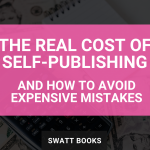Have you ever considered what happens to your original book artwork once your manuscript is published?
For many self-published authors, the excitement of seeing their book come to life overshadows a crucial detail—retaining ownership of their original book artwork. Yet, failing to secure the original design files can lead to unexpected costs, branding limitations, and even legal hurdles down the line.
Your book’s artwork is more than just a pretty cover; it’s an essential part of your brand, marketability, and future publishing opportunities. Whether you plan to release a second edition, adapt your book for multiple formats, or repurpose the design for marketing materials, owning your original book artwork ensures you stay in control—not at the mercy of a designer, publisher, or third-party service.
In this article, we’ll explore why retaining your book’s artwork is a non-negotiable asset for self-published authors and how traditional authors can also face challenges when they don’t control their book’s visual identity. Let’s dive in and make sure you never lose ownership of this critical piece of your publishing success.
The Importance of Owning Your Book’s Artwork
Self-publishing a business book is an exciting milestone, allowing you to establish credibility, share your expertise, and build your personal brand. However, amidst the writing, editing, and marketing process, many authors overlook a crucial aspect of self-publishing success: retaining ownership of their book’s original artwork.
From cover design to promotional materials, your book’s artwork is an essential part of its branding and marketability. If you don’t secure and retain the original design files, you may face:
❌ Limited control over future editions or rebranding
❌ Unexpected costs for repurchasing or recreating artwork
❌ Legal and rights issues with designers or publishers
Control Over Your Intellectual Property
As a self-published business author, your book and its associated artwork are your intellectual property. Retaining your artwork files ensures that you:
✅ Have full control over how and where your artwork is used.
✅ Can update, modify, or repurpose the design without restrictions.
✅ Avoid conflicts with designers or publishers regarding ownership rights.
Why This Matters:
Imagine you want to create a rebranded edition of your book with an updated cover, or you need to adjust the design for a new format (e.g., hardcover or eBook). If you don’t own the original files, you could be forced to pay extra fees—or worse, you may not have access to your own artwork at all.
💡 Takeaway:
Always secure the source files for your book’s artwork to maintain full creative and commercial control.
Flexibility for Future Editions or Formats
If you plan to release multiple editions of your book—such as a paperback, hardcover, eBook, or audiobook—having access to your original artwork ensures seamless adaptation.
How It Helps:
📖 New Editions: Easily update the design for revised editions or anniversary releases.
🎧 Audiobooks: Adjust cover dimensions to meet platform specifications (e.g., Audible requires square images).
📲 eBooks: Optimize for different digital formats and resolutions.
Example:
Many business authors expand their books into workbooks, special editions, or translated versions. Without the original artwork, you may struggle to create a consistent visual identity across all formats.
💡 Pro Tip:
Ensure you have layered files (PSD, AI) and high-resolution versions of your book cover for maximum flexibility.
Avoiding Additional Costs
One of the biggest risks of not retaining your artwork files is the potential financial cost of repurchasing or recreating designs.
Common Costly Scenarios:
💰 Paying to repurchase artwork: Some designers retain ownership and may charge licensing fees for future use.
💰 Hiring a new designer to recreate lost files: If your original designer is unavailable, you may need to pay for a new design from scratch.
💰 Unexpected revision fees: Without original files, even minor updates could require expensive redesign work.
Example:
An author decides to change their book’s subtitle for a second edition but doesn’t have the original cover file. The designer charges them hundreds of dollars to make a small adjustment.
💡 Takeaway:
Retaining your artwork saves you money by preventing unnecessary repurchasing or redesigning fees.
Brand Consistency Across Platforms
A business book isn’t just a standalone product—it’s a key part of your personal brand.
If you plan to create:
✔️ Spin-offs or sequels
✔️ Branded workbooks or courses
✔️ Merchandise and promotional materials
…you’ll need access to your original artwork to maintain a cohesive visual identity.
Why It’s Important:
A consistent brand builds recognition and trust among your audience.
Using high-quality, original artwork prevents pixelation and mismatched design elements.
A well-branded book enhances your authority as a business expert.
💡 Pro Tip:
Keep your fonts, colours, and design elements consistent across all books and marketing materials.
Protecting Against Rights Limitations
Traditional publishing contracts often give publishers control over book covers and artwork. However, self-published authors can face similar issues if they fail to secure ownership of their artwork.
Common Pitfalls to Avoid:
⚠️ Some designers include clauses that restrict how you can use your book cover.
⚠️ If a publishing service creates your artwork, they may own it—not you.
⚠️ Not having a clear contract can result in legal disputes over usage rights.
Solution:
- Negotiate full ownership rights when hiring a designer.
- Ensure your contract states that the artwork belongs to you.
- Request all source files upfront to avoid disputes later.
💡 Takeaway:
Don’t assume you own your book’s artwork—get it in writing.
Independence from Designers or Publishers
If you don’t retain your artwork, you could become dependent on a single designer or publishing service.
Why This is Risky:
🚨 If your designer closes their business, you may lose access to your files.
🚨 If you work with a publisher, they may limit your usage rights.
🚨 You may have difficulty making updates if your original designer is unavailable.
Example:
An author wants to move their book to a new distributor, but the original publishing service refuses to release their cover files. They are forced to redesign the entire book cover from scratch.
💡 Solution:
Always store backup copies of your artwork files so you can maintain independence.
Maximising Marketing and Promotional Opportunities
Your book cover and artwork aren’t just for the book itself—they’re essential for marketing and promotional campaigns.
Ways to Use Your Artwork for Marketing:
📌 Social Media Graphics: Eye-catching promotional images.
📌 Banners & Posters: For book launches, speaking engagements, and events.
📌 Branded Merchandise: T-shirts, mugs, and other promotional items.
💡 Pro Tip:
Having original artwork files allows you to resize, modify, and optimise images for different marketing needs.
Protecting Your Book’s Legacy and Longevity
If your business book is successful, you may want to release new editions, anniversary reprints, or digital updates years down the line. Retaining your original artwork ensures that your book remains relevant and adaptable for the future.
Long-Term Benefits:
✅ Allows for revisions and updates without needing a full redesign.
✅ Ensures high-quality reprints for future editions.
✅ Preserves your creative vision without third-party restrictions.
💡 Takeaway:
Keeping your artwork files ensures your book can evolve over time without unnecessary roadblocks.
Practical Tips for Authors: How to Secure Your Artwork Files
📌 Request These File Types from Your Designer:
- Source Files: AI (Adobe Illustrator), PSD (Photoshop), or INDD (InDesign).
- High-Resolution Formats: PNG, JPEG, and PDF.
- Font & Colour Details: To maintain branding consistency.
📌 Include This in Your Design Contract:
- A clause stating you own the full rights to the artwork.
- An agreement that all source files will be provided upon project completion.
- Permission to modify and reuse the artwork as needed.
Final Thoughts: Advocate for Your Rights as an Author
Retaining your book’s original artwork is not an unreasonable request—it’s a standard best practice for self-published authors. By securing ownership, you protect your book’s branding, marketing potential, and long-term value.
💡 Final Advice:
Always request and store your artwork files—it’s your book, your brand, and your intellectual property. 🔒
Our standard operating procedure at SWATT Books is that all original and production artwork files are delivered to the author as part of a handover pack, as well as metadata files, ISBN allocations and login details to all distribution accounts. This ensures that our authors are 100% in control and ownership of EVERYTHING.
Your book is more than just words on a page—it’s your brand, your message, and a powerful tool for building authority in your industry. Retaining ownership of your original book artwork ensures that you stay in full control of your book’s branding, distribution, and long-term success. By securing your design files upfront, you avoid unnecessary costs, branding inconsistencies, and frustrating limitations down the line.
Whether you’re self-publishing your first book or navigating the complexities of a traditional publishing contract, taking ownership of your artwork is a non-negotiable step in protecting your intellectual property. Don’t let a simple oversight create costly roadblocks in the future.
🚀 Ready to Publish? Let’s Get Your Book Out Into the World!
If you have a finished manuscript and are ready to take the next step, I can help ensure you retain full control of your book—including its artwork, metadata, and distribution rights. Book a free initial consultation with me today, and let’s discuss the best publishing strategy for your book.
📝 Still Writing? Get Your Free Write Strategy Checklist!
If you’re still in the planning or writing stages, having a clear roadmap will save you time, stress, and costly mistakes. Download my Write Strategy Checklist to confidently navigate every stage of the book creation process—from writing and editing to cover design and publishing—while ensuring you retain full control over your book’s assets.





